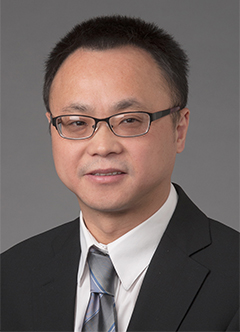Vision
|
Center Director, PI
Xiaobo Zhou, PhD
Dr. & Mrs. Carl V. Vartian Professor
Areas of Expertise
» Bioinformatics
» Systems Biology
» Imaging Informatics
» Clinical and Translational Informatics
» Computational Surgery
click for full bio
|
 |
Personalized and precision medicine seeks to redefine our understanding of disease onset and progression, treatment response, and health outcomes through the more precise measurement of molecular, imaging, environmental, and behavioral factors related to health and disease. A new era of healthcare is coming by the combination of a highly engaged population and rich biological, health, behavioral, and environmental data. By collaborating with biologists, pathologists, radiologists, mathematicians, bioengineers, and clinicians, the utmost goal of our scientific research is to be a leader in the development and applications of novel systems bioinformatic and imaging methods, molecular diagnosis and treatment as well as the integration of them into clinics and disease monitoring for personalized and precision medicine. This approach can be generally called Systems Medicine. To reach this goal, our center will focus on developing advanced clinical and translational informatics, biomedical imaging informatics tools, bioengineering and systematic modeling tools by integrating heterogeneous big datasets from multiple sources (e.g., clinical, imaging, EMR, genomic, behavioral, social, population, environmental, and other data sources) to address challenging problems in patient care, health prevention, and biomedical discoveries to improve clinical and translation research. Our immediate goal is to attract NIH, NSF, CPRIT, and other foundation grants, and to publish original discoveries and clinical supporting systems in high profiling journals to address precision human health challenges. CSM will conduct research along three dimensions:
- Systems Informatics & Physics (SIP) Guided Precision Medicine - Our medical imaging informatics and medical physics mainly focus on developing imaging analysis tools, biomechanical properties using Finite Elemental Model, and machine learning tools to guide surgical planning and therapy. Major topics include, but not limited to:
- Medical image segmentation, registration, quantification, and patient restratification based on image features, demographic, diagnostic features, and physic features.
- Biomechanical properties of different tissues and organs for patients with different behavior.
- Optimization of medical device parameters at systems level for clinical outcome and precision medicine based on clinical factors, image features, biomechanical features.
- Clinic-wide applications with the optimized medical devices and precision therapy.
- Clinical and Translational Big Data Informatics (CTI). We are developing Translational Data Warehouse (TDW) on the top of i2b2 platform. The TDW represents a centralized data repository aggregating data from non-clinical data sources, including Pre-Clinical imaging, and shared Resource Cores, and from clinical and clinical research data sources including the clinical electronic medical record (EMR), Epic, Population Science Signature Program (PSSP) research databases, Clinical Research Imaging, cancer registry, claims data, sequencing data and omics data. Major topics include, but not limited to:
- Developing Big Data Sciences for Personalized Medicine (BD4PM) system, a biomedical Big Data informatics platform that allows fast adaptation of novel datasets by systematic data harmonization and knowledge management mechanisms. It expedites personalized medicine by providing user-oriented toolkits established on a scalable translational knowledge library. It seeks to investigate and develop a complete set of tools and resources that will enable signatures to be most effectively extracted from big data and applied to personalized medicine.
- Human-centered design: design health information systems to fit users’ characteristics instead of training users to adapt to poorly designed technology.
- Simulation and modeling: models and simulations of teamwork from the level of molecular activities to the levels of individual behaviors and distributed systems.
- Translational Systems Bioinformatics and Systems Biology (SBSB). To investigate certain hypothesis, Systems Biology/Medicine approach is to integrate biological/medical experiments and systems modeling at different scales (molecular, cellular tissue, organ and population levels) seamlessly to answer various biological and medical questions. When the data are generated, bioinformatics approaches are developed to analyze genomics, genome-wide association studies, mass spectrometry proteomics, and metabonomics technologies to identify candidate disease biomarkers and potential targets. Major topics include, but not limited to:
- Novel bioinformatics tool development: for analyzing various sequencing data and omics data for understanding disease initiation, recurrence, migration, and target discovery
- Systems modeling guided translational cancer research
- Systems modeling guided regenerative medicine
- Systems immune study
CSM is composed of the following types of researchers:
- Clinicians, clinical scientists, physicians and surgeons, who have clinic problems in their daily operating, and can also identify significant research issues in our hospitals, and also perform clinical research as part of their practice as clinicians.
- Molecular and cellular Biologists, who can work with informatics scientists to come up with hypothesis, and generate data that can be transformed into knowledge by simulation, analysis, modeling, data mining, and visualization
- Computer scientists, who adapt and deploy resources from computational sciences to solve significant cognitive biomedical problems
- Informatics researchers, who study the acquisition, representation, transmission, and use of information by clinicians and biomedical researchers to solve significant clinical and research problems
